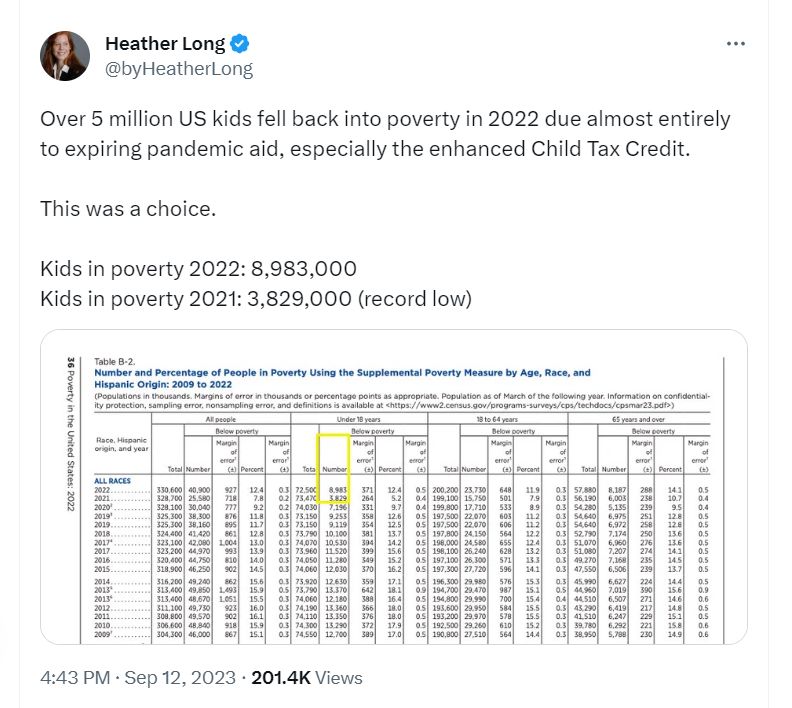Welcome to DU!
The truly grassroots left-of-center political community where regular people, not algorithms, drive the discussions and set the standards.
Join the community:
Create a free account
Support DU (and get rid of ads!):
Become a Star Member
Latest Breaking News
General Discussion
The DU Lounge
All Forums
Issue Forums
Culture Forums
Alliance Forums
Region Forums
Support Forums
Help & Search
General Discussion
Related: Editorials & Other Articles, Issue Forums, Alliance Forums, Region ForumsThe Poverty Yo-Yo

New Census Bureau statistics show that abandoning the successful anti-poverty interventions of the pandemic has put the nation right back where it started.
https://prospect.org/economy/2023-09-13-poverty-yo-yo/
If the guys from Men in Black wiped your memory clean with a neuralyzer and erased the years 2020 and 2021 (which wouldn’t be such a bad idea), you would have greeted yesterday’s release of the Census Bureau’s 2022 Income, Poverty and Health Insurance reports with mostly a shrug. The Supplemental Poverty Measure (which includes taxes and transfer payments and other factors, providing a more credible picture of a person’s financial picture) shows that poverty rose modestly from 2019 to 2022, from 11.8 percent to 12.4 percent. For children under 18, poverty actually fell slightly, from 12.6 percent to 12.4 percent. There is a problem among seniors, where poverty is rising, from 12.8 percent in 2019 to 14.1 percent in 2022.
Reading these figures, you get the sense of a country that still has nagging problems with poverty, despite near record-low unemployment and national wealth. And you can see the higher cost of living as contributing to this struggle. But if you have any memory of 2020 and 2021, the story becomes quite a bit more tragic. In 2020, the onset of the COVID pandemic led the United States to scramble to construct a working social safety net on the fly, to account for the fact that millions of people would be either out of work or confined to their homes. Congress provided three rounds of cash payments, and boosted weekly unemployment insurance to a level well above poverty, not to mention many workers’ incomes. In 2021, the American Rescue Plan enhanced the Child Tax Credit, increasing its value, making it a monthly advance payment, and removing the work requirement so the very poor were included for the first time.
This all combined with boosted food aid, expansion of the Medicaid rolls, rental assistance, a bigger Earned Income Tax Credit, and other supports. The results are clear in the poverty statistics. It turns out you can cure a lack of money by simply delivering wads of cash. In 2020, the Supplemental Poverty Measure for all people dropped from 11.8 percent to 9.2 percent. In 2021, it fell even further, to 7.8 percent. Only in 2022, after the checks stopped coming and unemployment retreated to its miserly level and the enhanced Child Tax Credit and other measures expired, did poverty shoot back up again. For children, the sequence goes: 12.6 percent in 2019, 9.7 percent in 2020, an incredible 5.2 percent in 2021, and all the way back to 12.4 percent in 2022.
That translates into 5.1 million kids moving back into poverty, with all the trauma and long-term damage associated with that, because Congress couldn’t be bothered to continue a program that was working to eradicate it from American life. Specifically, because congressional Republicans and Joe Manchin, who refused to extend the enhanced Child Tax Credit on the grounds that parents used the money to buy drugs, couldn’t be bothered. “A spike in child poverty like this didn’t need to happen. Congress had the chance to extend these programs that would keep our children fed and boost working families out of poverty. But it didn’t. It’s shameful,” Sen. John Fetterman (D-PA) said in a statement.
Link to tweet
snip
snapshot of the tweet


InfoView thread info, including edit history
TrashPut this thread in your Trash Can (My DU » Trash Can)
BookmarkAdd this thread to your Bookmarks (My DU » Bookmarks)
0 replies, 384 views
ShareGet links to this post and/or share on social media
AlertAlert this post for a rule violation
PowersThere are no powers you can use on this post
EditCannot edit other people's posts
ReplyReply to this post
EditCannot edit other people's posts
Rec (4)
ReplyReply to this post